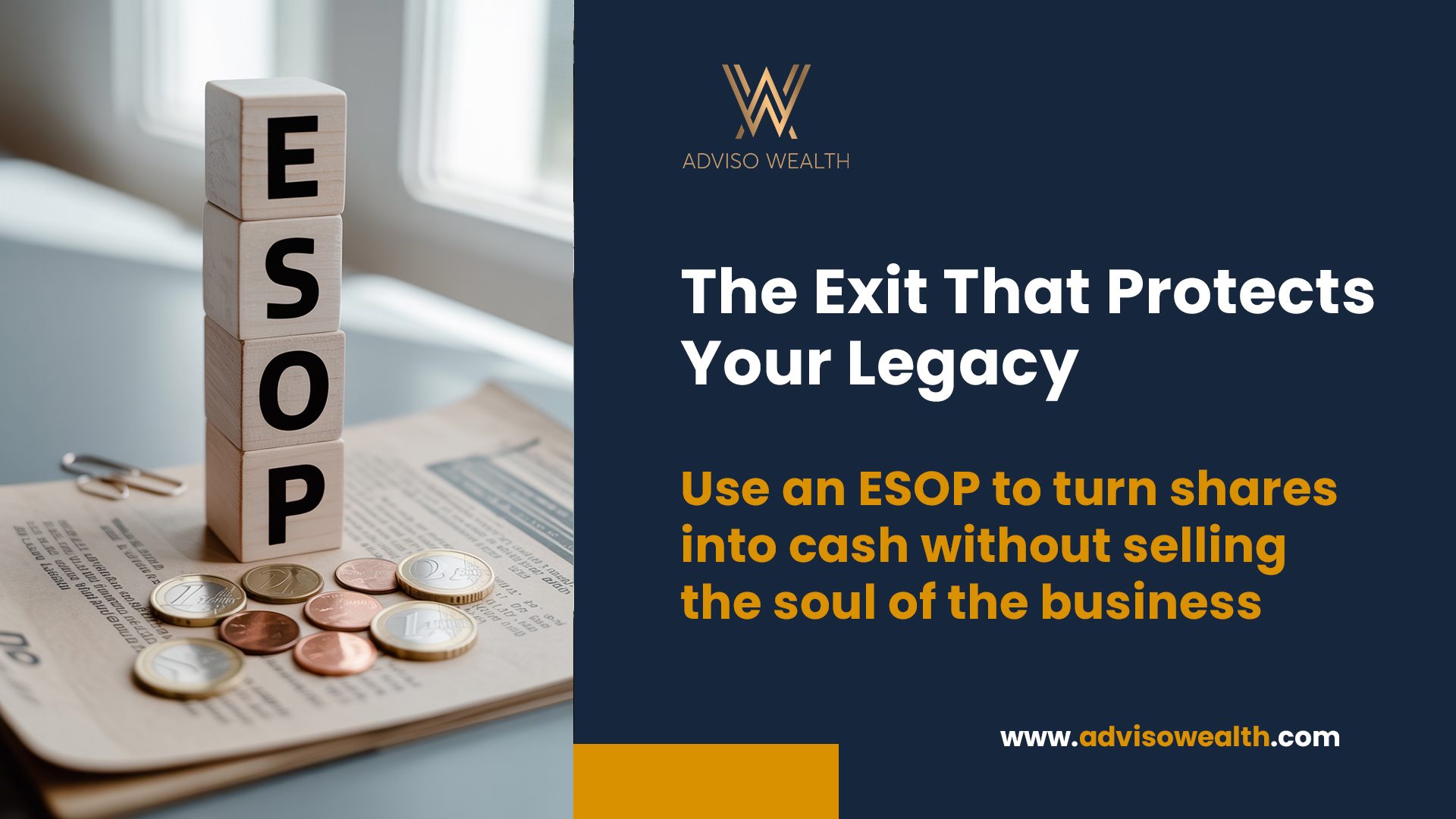ESOPs: The Misunderstood Exit Strategy Every Business Owner Should Know

You’ve spent decades building your business—nurturing it through growing pains, taking risks, reinvesting every dollar, and turning it into something worth protecting. And now, the question lingers:
“How do I eventually exit my business without losing control, paying unnecessary taxes, or selling to someone who doesn’t care about my legacy?”
For many owners, the obvious options—selling to a competitor, handing it down to family, or pursuing private equity—don’t quite fit. One path that deserves more attention is the ESOP(Employee Stock Ownership Plan).
An ESOP isn’t the right answer for every company. But for the right owner, it can be a flexible, tax-efficient, and legacy-preserving exit strategy.
Let’s break it down.
What Exactly Is an ESOP?
An Employee Stock Ownership Plan (ESOP) is a qualified retirement plan that allows employees to become beneficial owners of company stock—without having to purchase shares themselves.
From an owner’s perspective, an ESOP can function much like a third-party sale: you receive liquidity for shares, the company secures financing, and there’s a structured transition. But ESOPs bring unique features:
- Flexibility: Owners can sell a portion or the entirety of their shares over time.
- Tax Advantages: Certain structures may allow owners and companies to reduce or defer
taxes. - Exit Strategy: ESOPs allow owners to stay involved during the transition and preserve
culture.
The Flexibility Owners Crave
No two exits look alike. Some owners want to diversify 40% of their wealth while staying at the helm. Others want to gradually de-risk and eventually step aside. ESOPs provide tools to support both:
- Partial Sales: You can sell a minority interest today, maintain control, and revisit future
sales later. - Different Timelines: ESOPs can help address co-owners with different retirement
horizons. - Continuity: Employees already know the business, which often makes the transition
smoother than an outside sale.
Think of it as creating an exit on your own timeline—not on a buyer’s.
The Tax Efficiency That Stands Out
Taxes are often one of the biggest costs in a business sale. ESOPs offer some favorable tax treatment if structured correctly.
Section 1042 Rollover
If you sell stock to an ESOP, Section 1042 of the Internal Revenue Code may allow you to defer capital gains taxes—provided specific requirements are met:
- The company must be an active U.S. operating company.
- At least 30% of the stock must be sold to the ESOP.
- The company must be a C-Corp at the time of sale.
When handled properly, this can meaningfully reduce the tax burden of a sale. The rules, however, are technical—owners should review them carefully with their CPA and attorney.
Corporate Tax Advantages
- C-Corp Deduction: C-Corps may be able to deduct both principal and interest on ESOP
loans (within IRS limits). - S-Corp Advantage: If an ESOP owns 100% of an S-Corp, the company itself may
become exempt from federal income taxes. That free cash flow can instead go toward
reinvestment or debt service.
Employee Benefits
Employees typically do not pay taxes on their ESOP shares until they receive distributions(retirement, disability, or death). In this sense, ESOP benefits function much like an IRA:
accounts grow tax-deferred over time.
ESOPs as an Exit Strategy
An ESOP is rarely a quick sale.
If you need to exit within 12 months, this path may not fit. ESOPs often take years to fully
transition and de-lever. They work best for owners willing to stay engaged for at least several
years after the initial transaction.
For those who still have energy for the business but want liquidity and diversification, an
ESOP can provide both—while also setting up a smoother handoff down the road.
How an ESOP Actually Works
Here’s the typical flow of funds:
- External Loan: A bank lends money to the company.
- Internal Loan: The company then loans those funds to the ESOP.
- Purchase: The ESOP uses those funds to purchase shares from the selling owner.
- Repayment: As the company pays back the bank, shares are gradually released to employees.
Important points:
- Employees don’t fund the ESOP personally.
- The company receives tax deductions on its contributions (within limits).
- The owner receives liquidity, while employees benefit gradually as shares vest.
Who Makes a Good ESOP Candidate?
Not every company is a good fit. Strong ESOP candidates often share these characteristics:
- Consistent Cash Flow – Lenders need confidence the company can handle ESOP debt.
- Low Existing Debt – The less leveraged the balance sheet, the easier the deal.
- 30+ Employees – Fewer than 20 employees can make the economics challenging.
- Strong Management Team – Without a strategic buyer, the business needs steady leadership.
- Long-Term Mindset – ESOPs are a multi-year process, not an immediate exit.
Why Business Owners Consider ESOPs
For most owners, the decision is about more than just the numbers. Common motivations
include:
- Tax planning: Depending on the structure, ESOPs may provide meaningful deferrals or
reductions. - Control: Owners can often remain active in leadership after the sale.
- Liquidity: A partial sale allows owners to diversify without stepping away entirely.
- Family Involvement: An ESOP can leave room for children or family members to
remain active in the business. - Legacy: ESOPs reward employees who helped build the company and help preserve
community ties.
Common Misconceptions
- “Employees can’t afford to buy me out.”
ESOPs don’t rely on employees writing checks. The trust is funded by company
borrowing. - “I’ll lose all control.”
Owners can often maintain significant influence after an ESOP transaction. - “It costs too much.”
ESOPs do require professional fees and annual valuations, but compared to a third-party
sale, costs are often competitive.
The ESOP Process
- Build a Professional Team: Because ESOPs are regulated under ERISA, you’ll need experienced advisors (attorney, CPA, trustee, investment banker).
- Feasibility Study: Determine enterprise value, transaction structure, after-tax benefits, and affordability.
- Transaction: Usually 4–6 months from start to finish. Liquidity is provided to the seller, and shares begin flowing to employees.
- Ongoing Management: Annual valuations, trustee oversight, and governance
requirements continue.
ESOPs vs. Other Exit Options
- Partial vs. 100% Sale: A partial ESOP can allow you to diversify while benefiting from
future growth. A 100% sale provides a cleaner exit if you feel the business has plateaued. - C-Corp vs. S-Corp: C-Corp structures may favor the owner (capital gains deferral
opportunities). S-Corp structures may favor the company (federal tax exemption at 100%
ESOP ownership). - Private Equity vs. ESOP: Private equity usually offers liquidity but less control. ESOPs
provide liquidity with cultural continuity.
Final Thoughts: Is an ESOP Right for You?
An ESOP isn’t for everyone. It’s not the simplest or the fastest way to exit. But for some owners,
it provides a rare mix of liquidity, flexibility, tax benefits, and legacy preservation.
Here’s the key: you don’t get a second chance at selling your business. After decades of effort,
you deserve to understand every option available so you don’t leave something valuable behind.
The real question is: Does an ESOP align with your goals, timeline, and values?
Ready to Explore Whether an ESOP Fits Your Exit?
Disclaimer
All written content is for information purposes only. Opinions expressed herein are solely those of Adviso Wealth, unless otherwise specifically cited. Material presented is believed to be from reliable sources and no representations are made by our firm as to another parties’ informational accuracy or completeness. All information or ideas provided should be discussed in detail with an advisor, accountant or legal counsel prior to implementation.
